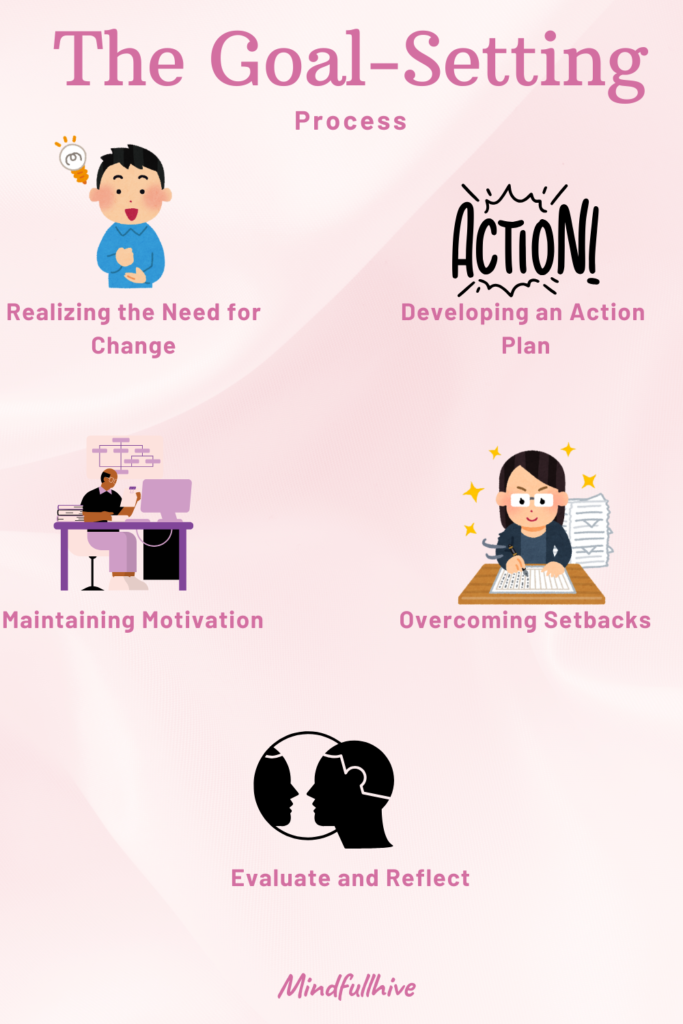Goal setting has been a life-changing tool for me—a 25-year-old woman navigating the ups and downs of personal development and career growth. In this blog, I share my personal journey, real-life experiences, and practical tips that have helped me overcome challenges and achieve both small and big dreams. If you’ve ever wondered what do you understand by goal setting, then you’re in the right place. Let’s explore the definition of goal setting, its importance, various types of goals, and a detailed goal-setting process that even a beginner can follow.
Understanding the Fundamentals of Goal Setting
Setting clear goals has been one of the most effective strategies in my personal and professional development. When I first encountered goal setting, I was overwhelmed by the idea that my future could be planned and steered by my own decisions. Over time, I discovered that goal setting isn’t just about writing down what you want—it’s about creating a structured action plan that fuels your motivation and guides your performance improvement.
Definition of Goal Setting
Goal setting is the process of defining specific, measurable, and time-bound objectives that lead to personal and professional growth. Simply put, it is a systematic approach to create a roadmap for success.
-
Concise Definition:
- What do you understand by goal setting? It involves establishing clear specific goals that are measurable, achievable, relevant, and time-bound—a concept popularly known as SMART goals.
- It is both a creative and analytical process that requires self-reflection and planning.
- A well-defined goal is not just a wish; it is a performance target that drives daily actions and decisions.
-
Key Components:
- Specific Goals: Clearly defined targets that leave no room for ambiguity.
- Measurable Goals: Quantifiable markers to track progress.
- Achievable Goals: Realistic objectives that challenge you without being out of reach.
- Time-Bound Goals: Deadlines to create urgency and maintain focus.
This approach is grounded in goal-setting theory, which suggests that clear and challenging goals lead to higher performance when accompanied by feedback on progress.

Importance of Goal Setting
Over the years, I’ve learned that setting goals is not just a motivational exercise—it has a significant impact on your personal growth, productivity, and overall success. Here’s why goal setting is so important:
-
Direction and Focus:
- Helps channel your energy toward what truly matters.
- Acts as a compass that keeps you on track, even when distractions abound.
-
Enhanced Motivation:
- Provides clear objectives to work towards.
- Increases self-confidence as you meet and exceed your SMART criteria.
-
Improved Performance:
- Establishes measurable benchmarks for your performance improvement.
- Encourages continuous learning and adaptation.
-
Personal Development:
- Fosters self-discipline and resilience.
- Drives you to step out of your comfort zone and try new things.
-
Effective Action Plan:
- A detailed plan ensures that each step is actionable and contributes toward reaching your ultimate goal.
Types of Goals
In my journey of personal development, I found that understanding the different types of goals helped me balance my personal and professional life. Here are some common types:
-
Short-Term Goals:
- Achievable within a few days or weeks.
- Serve as stepping stones for larger objectives.
-
Long-Term Goals:
- Span months or even years.
- Reflect broader visions like career advancement or major personal milestones.
-
Outcome Goals:
- Focus on the end result (e.g., achieving a promotion or launching a successful project).
-
Process Goals:
- Emphasize the journey and daily habits (e.g., dedicating 30 minutes daily to skill improvement).
-
Personal Development Goals:
- Target areas like learning new skills, enhancing creativity, or improving motivation.
-
Professional Goals:
- Aim at career progression, increasing performance, or developing leadership qualities.
Understanding the different types of goals helps tailor the goal-setting process to your unique needs and ensures a balanced approach to personal development.
The Goal-Setting Process
Creating an actionable and realistic goal-setting process was a turning point in my life. Here’s a step-by-step breakdown of the process that has worked wonders for me:
-
Identify Your Vision:
- Reflect on your life’s aspirations.
- Write down what you want to achieve in the long run.
-
Set Specific Objectives:
- Break your vision into specific goals.
- Make sure each objective follows the SMART criteria: specific, measurable, achievable, relevant, and time-bound.
-
Develop an Action Plan:
- Create a detailed list of steps you need to take.
- Include deadlines and performance benchmarks to monitor your progress.
- Example: “I will dedicate one hour every morning to reading about new digital marketing trends to improve my skills.”
-
Monitor Your Progress:
- Track your achievements regularly.
- Adjust your action plan if necessary.
- Use tools like journals, apps, or spreadsheets to measure performance improvement.
-
Stay Motivated:
- Celebrate small wins.
- Use affirmations and visual reminders of your goals.
- Engage in communities (online or offline) that share similar ambitions.
-
Evaluate and Reflect:
- Periodically review your progress.
- Identify what worked and what needs improvement.
- Adapt your goals and action plan based on real-life challenges and successes.
Practical Applications and Personal Experiences with Goal Setting
My journey with goal setting has not always been linear. Like many, I’ve experienced setbacks and redefined my objectives several times. Here, I share practical applications and real-life experiences that highlight how effective goal setting can transform your life.
A Personal Story of Transformation
A few years ago, I was at a crossroads in my career. Despite having big dreams, I lacked a clear direction. That all changed when I decided to embrace the concept of what do you understand by goal setting. I began by setting small, achievable goals that aligned with my vision for personal development. This is how my transformation unfolded:
- Realizing the Need for Change:
I was juggling multiple responsibilities and felt that I was drifting away from my true passion. It was then that I discovered the power of setting SMART goals—goals that were specific, measurable, achievable, relevant, and time-bound. - Developing an Action Plan:
I sat down with a notebook and mapped out my aspirations, from career progression to personal well-being. I broke these aspirations into actionable steps. For instance, I set a goal to enhance my digital marketing skills, dedicating an hour each day to online courses and practical projects. - Maintaining Motivation:
Every small victory motivated me further. I kept a daily journal to log my progress, which helped me stay focused and accountable. This habit became my secret to consistent motivation and performance improvement. - Overcoming Setbacks:
Not every goal was achieved on the first try. When I faced obstacles, I revisited my action plan, adjusted my specific goals, and recalibrated my expectations. This iterative process helped me understand that setbacks are simply stepping stones to success.
The Role of SMART Goals and Goal-Setting Theory
Implementing SMART criteria into my goal-setting process was a game changer. Here’s why the SMART framework is so effective:
-
Specific:
- Clearly define what you want to achieve.
- Helps in visualizing the end result and setting a clear target.
-
Measurable:
- Quantify your progress.
- Use metrics to gauge success, such as milestones or performance indicators.
-
Achievable:
- Ensure your goals are realistic.
- Set objectives that push you but are attainable with effort.
-
Relevant:
- Align goals with your overall life vision.
- Each goal should contribute to your broader ambitions and values.
-
Time-Bound:
- Set deadlines to create urgency.
- A clear timeframe ensures that goals are pursued consistently.
This structured approach is rooted in goal-setting theory, which emphasizes that clearly defined goals result in higher motivation and better outcomes. It’s a framework that has empowered me to take control of my destiny and achieve breakthroughs in both my personal and professional life.
Integrating Goal Setting into Daily Life
Incorporating goal setting into everyday routines is essential for continuous personal development. Here’s how I’ve integrated these practices into my daily life:
-
Morning Rituals:
- Start each day with a review of my goals.
- Write down three key objectives for the day to maintain focus.
-
Weekly Reviews:
- Every Sunday, I spend time evaluating my progress.
- I adjust my upcoming week’s goals based on what I’ve learned, ensuring an ongoing cycle of reflection and improvement.
-
Visual Reminders:
- I keep sticky notes and vision boards around my workspace.
- Thesect as constant reminders of my action plan and objectives.
-
Digital Tools:
- I use goal tracking apps that help me monitor my performance improvement.
- These apps send me reminders and allow me to celebrate small wins.
-
Community and Mentorship:
- Joining online groups and local workshops keeps me inspired.
- I share my experiences and learn from others who are also passionate about personal development and effective goal setting.
Balancing Multiple Goals: Tips and Tricks
Sometimes, having too many goals can feel overwhelming. Here are some practical tips that have helped me strike a balance:
-
Prioritize Your Goals:
- List your goals and rank them in order of importance.
- Focus on high-impact objectives first, ensuring each step contributes to your broader vision.
-
Break Down Larger Goals:
- Divide long-term goals into smaller, manageable tasks.
- Create an action plan that outlines each step towards achieving your objectives.
-
Use a Planner:
- Whether digital or paper-based, a planner helps organize daily tasks and long-term plans.
- Tracking your progress with measurable goals can significantly enhance your motivation and performance.
-
Stay Flexible:
- Life is unpredictable. Adapt your goals as circumstances change.
- Continuous reflection is key—sometimes what you set out to achieve might need slight adjustments along the way.
-
Seek Feedback:
- Don’t hesitate to ask for advice from mentors or peers.
- Constructive feedback helps refine your goal-setting process and ensures that your targets remain aligned with your personal growth.
For those interested in expanding their knowledge on related topics, I highly recommend exploring some of my other posts:
- Goals to Set for 2025 – Discover future-oriented goals and planning strategies.
- 7 Steps to Goal Setting – A step-by-step guide to establishing clear and actionable goals.
- SMART Goals Examples for Work – Practical examples on applying SMART goals in a professional setting.
Actionable Tips, FAQs, and Additional Insights
2 Quick Tips for Effective Goal Setting
-
Start Small, Think Big:
- Break down large objectives into achievable, bite-sized tasks.
- Celebrate every small win to boost your motivation and confidence.
-
Visualize Your Success:
- Create a vision board or digital scrapbook that represents your goals.
- Use these visuals as daily reminders to stay focused and driven.
5 Frequently Asked Questions (FAQs)
-
What do you understand by goal setting?
- Answer: Goal setting is a systematic approach to establishing clear, actionable targets that guide your personal and professional growth. It involves creating an action plan based on SMART criteria to drive performance improvement and maintain motivation.
-
Why is goal setting important in personal development?
- Answer: It provides direction, boosts motivation, and creates measurable benchmarks that help you track progress. By breaking down aspirations into specific goals, you can overcome challenges more efficiently.
-
How do I set SMART goals?
- Answer: Begin by defining goals that are specific, measurable, achievable, relevant, and time-bound. Use an action plan to map out the steps required, and regularly review your progress to ensure you’re on track.
-
What are the different types of goals I should consider?
- Answer: Consider a mix of short-term and long-term goals, as well as outcome and process goals. Balancing these helps maintain consistent progress in both personal development and professional performance.
-
How can I maintain motivation when facing setbacks?
- Answer: Regularly review your progress, celebrate small wins, and adapt your strategy if needed. Surround yourself with a supportive community, and always remember that setbacks are learning opportunities.
Additional Insights and Practical Strategies
-
Create an Effective Action Plan:
- Write down your objectives and the action plan for each goal.
- Use digital planners or traditional journals to keep track of progress.
- Break tasks into daily, weekly, and monthly segments.
-
Embrace Flexibility:
- Adjust your specific goals as needed.
- Life changes, and so should your plans.
-
Utilize Technology:
- Leverage apps and online tools that help with tracking measurable goals.
- Regularly update your performance metrics to stay aligned with your ambitions.
-
Stay Accountable:
- Share your goals with friends or mentors.
- Accountability partners or support groups can provide the push you need when motivation wanes.
-
Reflect and Revise:
- Take time to reflect on your progress weekly.
- Use failures as stepping stones to refine your goal-setting process.
A Personal Journey: From Uncertainty to Clarity
I remember a time when I felt lost and overwhelmed. As a young woman just starting my career, the idea of planning a future seemed intimidating. I had dreams but no clear action plan. My turning point came when I learned about what do you understand by goal setting and decided to implement it in my life.
Overcoming Early Challenges
-
Facing Self-Doubt:
- I was uncertain about my potential and the path I should take.
- Setting SMART goals allowed me to outline clear, actionable steps that gradually boosted my self-confidence.
-
Learning from Failures:
- Not every goal was met on the first try.
- Each setback was an opportunity to refine my approach and learn more about my own capabilities.
-
Building a Support System:
- Connecting with like-minded individuals provided a much-needed boost.
- I engaged in community forums and sought mentorship to help me stay accountable.
Celebrating Successes and Learning Every Day
-
Small Wins Matter:
- Every achievement, no matter how minor, was celebrated.
- These victories added up to significant progress over time, proving that consistent effort leads to success.
-
Reflecting on the Journey:
- Journaling my experiences helped me see how far I had come.
- I learned to appreciate the process of goal setting as much as the outcomes it produced.
-
Adopting a Growth Mindset:
- Embracing the idea that learning is a lifelong process transformed my approach.
- Each goal, whether achieved or not, contributed to my overall personal development.
Final Thoughts
Goal setting is not just a tool; it’s a way of life. It empowers you to take control, stay motivated, and continuously improve your performance. Whether you’re setting specific goals for your career or planning your personal growth, remember that the key lies in having a clear, actionable strategy.
-
Take Action Today:
- Reflect on your dreams and define what you truly want.
- Use the tips and strategies outlined in this blog to create your own action plan.
-
Stay Connected:
- I invite you to share your experiences and challenges in the comments section below.
- Let’s build a community that thrives on mutual support and shared successes.
By integrating goal setting into your daily routine and maintaining a flexible yet focused approach, you too can transform your life. As someone who has walked this path, I assure you that every step you take towards achieving your objectives is a step towards a more fulfilling future.
Wrapping Up: Your Journey to Success Begins Now
Goal setting has been my secret weapon in turning aspirations into tangible outcomes. The journey may have its ups and downs, but with a clear goal-setting process in place, you can navigate challenges with confidence and purpose.
Key Takeaways
-
Definition and Importance:
- What do you understand by goal setting? It is the foundation upon which success is built—defining clear, actionable, and measurable objectives.
-
Types of Goals:
- Differentiate between short-term, long-term, outcome, and process goals.
-
SMART Goals:
- Embrace the SMART criteria to ensure every goal is specific, measurable, achievable, relevant, and time-bound.
-
Personal Experience:
- Learn from my journey of overcoming setbacks and celebrating small wins.
-
Actionable Steps:
- Develop an effective action plan and monitor your progress diligently.
Your Next Steps
-
Review Your Goals:
- Spend some time today reflecting on your current goals.
- Write them down, ensuring each goal meets the SMART criteria.
-
Plan Your Day:
- Break your long-term goals into daily tasks.
- Use a planner or an app to track your progress.
-
Stay Inspired:
- Follow communities or blogs that motivate you.
- Keep a vision board or digital journal to remind you of your ultimate objectives.
Remember, this is your journey. Every small step counts, and every milestone reached is a testament to your hard work and commitment. Embrace the process, learn from your experiences, and watch your life transform one goal at a time.
By following the strategies and insights shared in this blog, you can create a clear, actionable plan to achieve your dreams. Whether you’re new to goal setting or refining an existing strategy, these practical tips and personal experiences are designed to help you succeed. Embrace your journey, and let goal setting be the roadmap that transforms your life.











